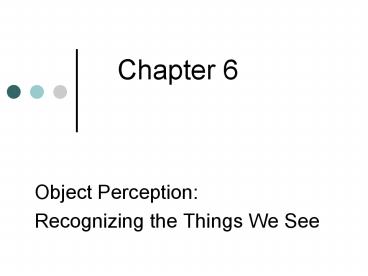Object Perception: PowerPoint PPT Presentation
1 / 21
Title: Object Perception:
1
Chapter 6
- Object Perception
- Recognizing the Things We See
2
Recognizing 3-D Objects
- Recognition by components
- According to this theory, a view of an object is
an arrangement of a few simple three-dimensional
forms called geometrical ions, or geons.
3
Recognizing 3-D Objects
4
Recognizing 3-D Objects
- Geons can be distinguished from one another in
any orientation. - Geons can be recognized when partially occluded
or obscured or even when intersections are
disconnected.
5
Recognizing 3-D Objects
- View-based recognition
- According to this theory, recognition of a
three-dimensional object depends on multiple,
stored views of objects. - Object recognition occurs when a current pattern
matches a stored pattern.
6
Learning to Recognize
- Visual priming involves an experience at one
moment influencing subsequent experiences. - This is a sign of visual plasticity.
7
Learning to Recognize
- Vernier acuity is the ability to perceive tiny
offsets between collinear lines.
8
Temporal Pathway and Object Recognition
- The brains temporal stream makes synaptic
connections in several areas of the temporal
lobes lower half. - This is known as the Inferiortemporal (IT)
cortex. - Visual perception interfaces with imagery and
memory in the IT.
9
Face Perception
- People are very good at reading faces for
information about age, gender, and emotional
state - Face-inversion effect An upside down face and an
inverted face are very difficult to recognize.
10
Prosopangnosia
- Prosopagnosia a patient can see and describe
another persons face but not recognize it. - Configural processing integrating various
features into a comprehensive, global
configuration - Featural processing singling out facial
components without integrating them
11
Greebles
- Greebles are three-dimensional,
computer-generated creatures that differ by
gender, family membership, and individual
identity. - People trained to identify greebles show
increased activation of face areas of the brain
when recognizing new greebles.
12
Greebles
13
Attention and Object Recognition
- Object-based attention is focused attention that
increases neural processing of an object and
enhances recognition. - Operates at the level of an entire object, not
just a certain spatial location.
14
Attention and Object Recognition
- Intentions and expectations engage a selective
process called attention that can modulate object
recognition.
15
Attention and Object Recognition
- The initial orientation to unusual objects that
pop out at you is dubbed preattentive vision.
16
Attention and Object Recognition
- Divided Attention - putting attention into 2
objects / tasks / scenes / etc.
17
Attention and Object Recognition
- Selective Attention - focusing attention on one
objects/tasks/scenes/etc. while ignoring another.
18
Attention and Object Recognition
- Attentional Capture - when attention is so
focused on one object that other objects are
ignored.
19
Attention can induce blindness
- Change blindness is the failure to notice an
otherwise conspicuous change because of a
diversion of attention. - http//www.csc.ncsu.edu/faculty/healey/PP/
20
Imagery Visions Little Helper
- Images generated by the imagination can easily be
confused with real stimuli. - Imagery and vision seem to share a common neural
basis. - Imagery and visual perception both involve the
primary visual cortex. - Mental images have less high spatial frequency
detail than do actual images. - The missing detail in mental images can be
encoded in words.
21
Imagery and Visual Perception

